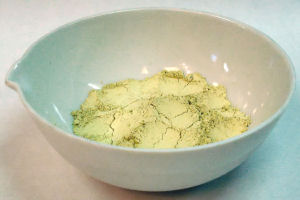Silver(I) carbonate facts for kids
Silver(I) carbonate is a special kind of chemical compound. Think of a chemical compound as two or more different chemical elements joined together. Its chemical formula is Ag2CO3. This means it has two silver atoms (Ag) and one carbonate group (CO3). The silver in this compound is in a special form called its +1 oxidation state, which just tells us how it likes to connect with other atoms.
Contents
What is Silver(I) Carbonate Like?
Silver(I) carbonate is a solid that looks yellow. It does not mix or "dissolve" in water, which means if you put it in water, it won't disappear like sugar does. When it touches acids, it reacts! This reaction creates carbon dioxide gas (the same gas we breathe out) and a type of salt that contains silver.
How is Silver(I) Carbonate Made?
Scientists can make silver(I) carbonate by mixing two other chemicals together. They combine sodium carbonate with silver nitrate. When these two chemicals meet, they react and form silver(I) carbonate.
What is Silver(I) Carbonate Used For?
One important use for silver(I) carbonate is as a catalyst. A catalyst is like a helper in a chemical reaction. It speeds up the reaction without being used up itself. Imagine a coach helping a team play faster without actually playing the game – that's what a catalyst does!
Staying Safe with Silver Compounds
It's important to be careful with silver compounds, including silver(I) carbonate. If they touch your skin, they can sometimes cause a little irritation. Also, if someone accidentally swallows silver compounds, it can be harmful and might even cause their skin to turn a blue color over time. This is why it's always important to handle chemicals with care and under adult supervision.
See Also


